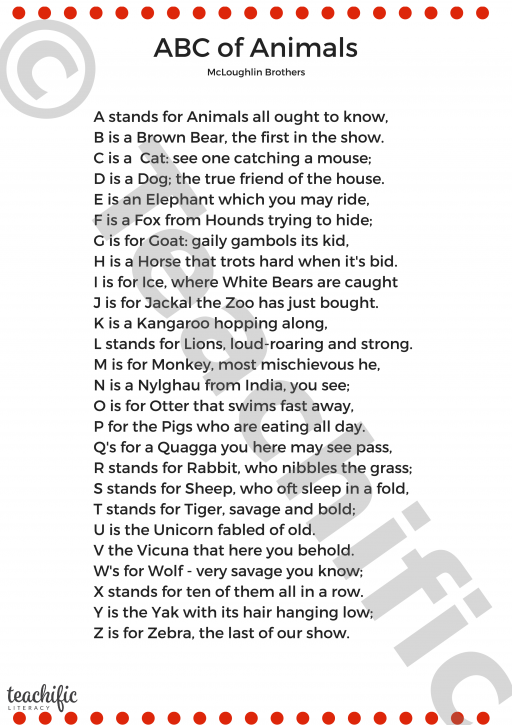About this teaching resource
Poems for children help them celebrate the joy and wonder of their world. Humorous poems tickle the funny bone of their imaginations. Charles Ghigna
We've sourced public domain poems to help create readers and writers who explore rhyme, rhythm, spelling patterns, letter knowledge, word meanings, punctuation; enable practice in fluency, expression, phrasing, visualising, prediciting, connecting; and provide inspiration, motivate poetic innovations, explore literary devices and create writers.
ABC of Animals: A poem using each letter of the alphabet for an animal. There will be some researching to do with this poem! Since it was written long ago the language is literary rather than everyday language, so it should generate plenty of discussion and questions. This poem works well as a class book of its very own. Assign an animal to each child, or pairs, to explore, research and illustrate. Dedicate a page to each animal. Links well to Biological Sciences. A great addition to any class made Big Book Poetry Collection.
Create a Big Book of poems from our collection for use during Shared Reading. (A4, enlarge to A3) Provide students with small versions of the same poems to enable independent practice.(A5, A4) Leave pages available for student illustrations, enabling them to fully engage in creating deep meaning.
For more ways to use poems during Shared Reading explore our mini lesson suggestions.
Australian curriculum alignment
Year 2
ACELT1592: Identify, reproduce and experiment with rhythmic, sound and word patterns in poems, chants, rhymes and songs.
Year 3
ACELT1600: Discuss the nature and effects of some language devices used to enhance meaning and shape the reader’s reaction, including rhythm and onomatopoeia in poetry and prose.
Year 4
ACELT1606: Understand, interpret and experiment with a range of devices and deliberate word play in poetry and other literary texts, for example nonsense words, spoonerisms, neologisms and puns.
Related books
Reviews
There are no reviews for this resource yet, why not write one?
Report a problem
Please log in to report a problem with this resource
Want this teaching resource?
Members get great benefits such as FREE access to premium resources like this one, discounts on courses and more.
Download includes: PDF 5 pages 127.8 kb




